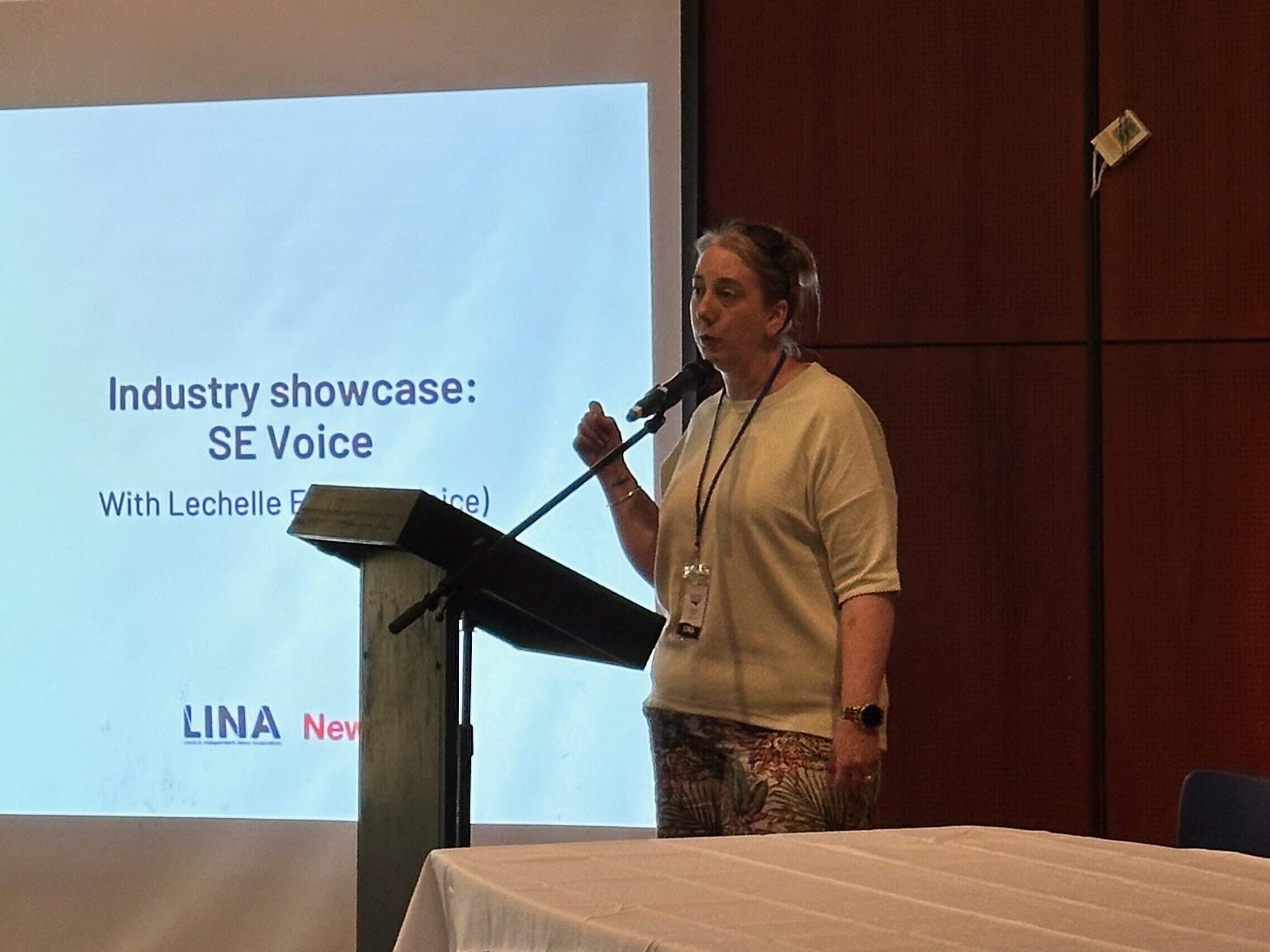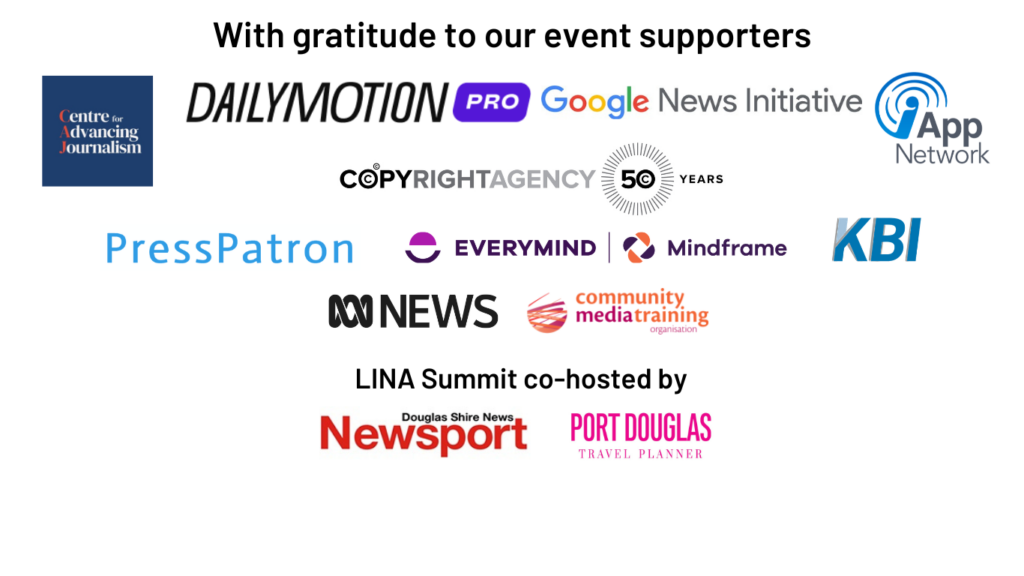Session Summaries
Conference kick-off
Summit co-hosts – Newsport, Kubirriwarra Yalanji Aboriginal Corporation – John Hartley.
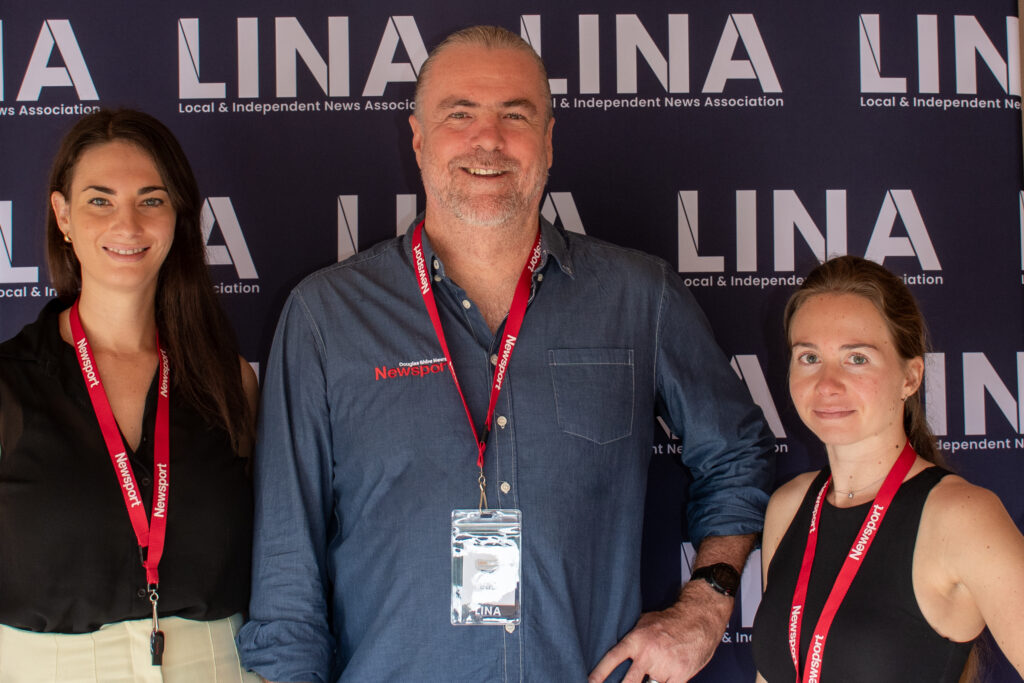
Our summit co-hosts Newsport kicked off the summit along with the LINA team and a Welcome to Country from Chair of the Kubirriwarra Yalanji Aboriginal Corporation John Hartley.
Keynote presentation
The Digital Guide – Tracy Sheen
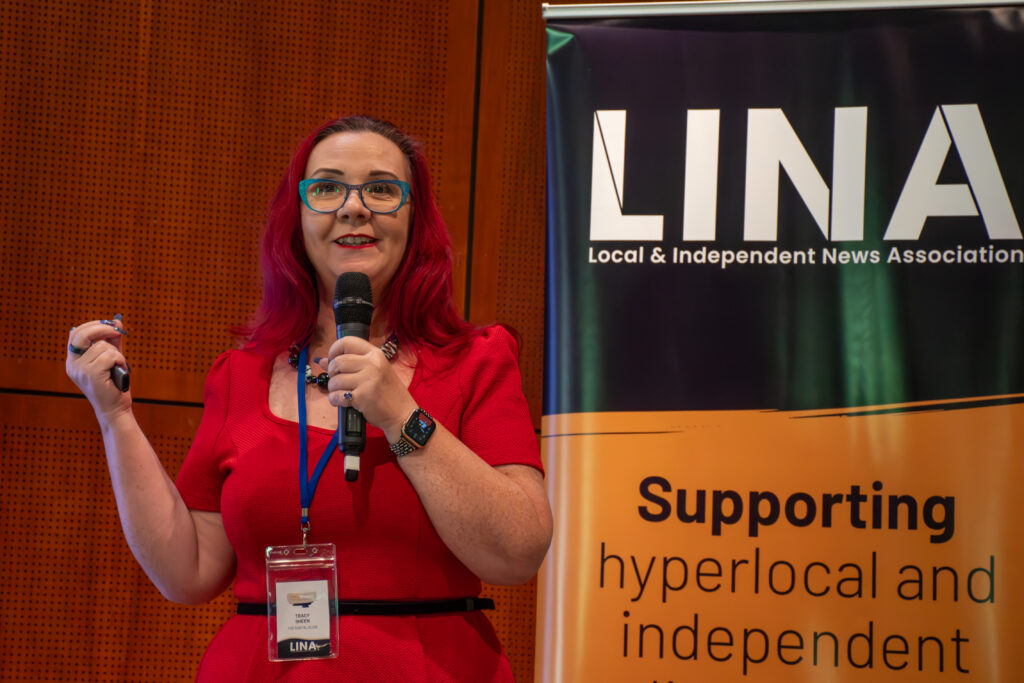
Author of The Digital Guide, Tracy Sheen helps empower small businesses with AI and digital tools. She shared insight into useful integrations of AI in small newsrooms and a little about what is coming down the pipeline, as we move into the next phase of “AI beginning to underpin new technology”.
Key takeaways
- AI tools can “change your life” when it comes to the work of journalists and publishers.
- Newsrooms should be implementing an AI strategy.
- Insurance companies will soon be asking newsrooms what their AI Governance policy is.
Next steps
- Develop an AI strategy using Tracy’s nine step implementation framework.
- Try out the dozen or more AI tools and platforms recommended by Tracy.
- Don’t sign up for an annual subscription: given how fast the industry is moving, it’s best to purchase AI tools on a month-to-month basis.
- Watch LINA Shop-Talks ‘Optimising Canva’, ‘Chatbots and Journalism’ and ‘From Platforms to AI’
Concerning Copyright
Copyright Agency – Lucinda Gardiner
An overview on copyright licensing as a possible revenue stream, with Copyright Agency Licensing and Compliance Manager Lucinda Gardiner. In this session Lucinda shared information on media monitoring licenses, research on the use of news publishing content by business, and answered questions on emerging copyright issues.
Key takeaways
Publishers can receive a passive income stream through copyright licensing when their work is used by others e.g. educational institutions.
Next steps
- Sign up to not-for-profit Copyright Agency to receive financial compensation (it’s free).
- Watch LINA Shop-talk ‘Copyright Licensing’ for more on this topic.
- Keep your details (particularly bank/payment details) up to date.
- If another media organisation has republished your work without attribution, contact them to ask them to rectify this.
AI in Action
The Digital Guide – Tracy Sheen
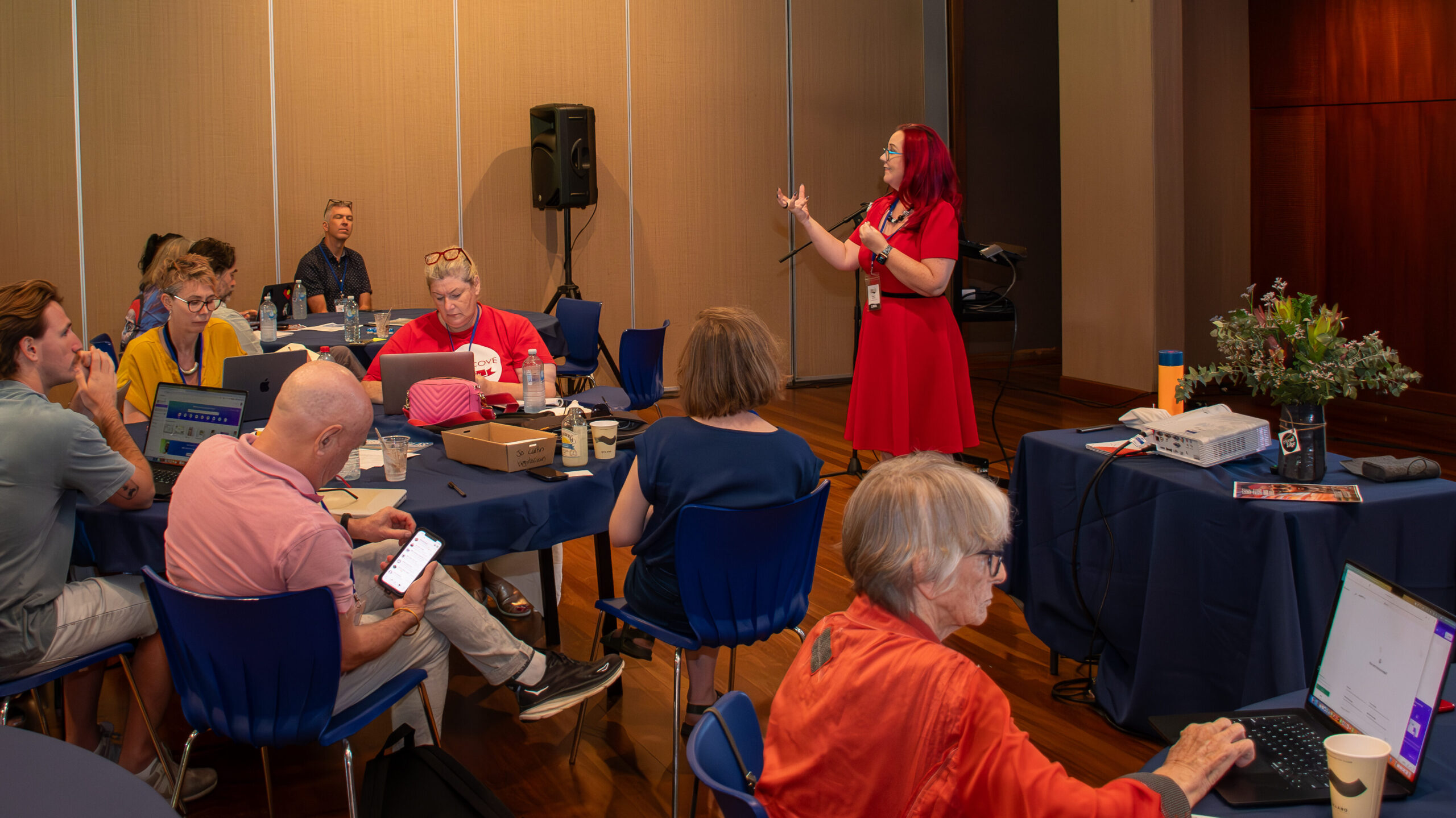
Tracy Sheen demonstrated how magic AI functions in Canva can be used to efficiently create well-designed social media tiles, and how to work between ChatGPT and Canva. Then, best practice for using LinkedIn as a business.
Key takeaways
- Structure your ChatGPT prompts following an “I am… you are…” structure. Using please and thank you provides 40% better responses.
- Some great AI apps within Canva are: Typecraft, Typegradient, DeepReal AI videos, Cast Magix, HeyGen AI avatars.
- On LinkedIn, posting one photo with a caption has the highest reach. For a carousel, 5-7 photos is optimal. Posting thrice per week on Tuesday, Wednesday and Thursday is ideal.
Next steps
- Keep an eye on trending apps on Canva.
- Post regularly on LinkedIn.
- Subscribe to Tracy’s newsletter for updated info on new services and ways to use AI.
- Watch LINA Shop-Talks ‘Optimising Canva’, ‘Chatbots and Journalism’ and ‘From Platforms to AI’
Smart Connections: Using tech to maximise digital reach
Community Broadcasting Association of Australia – Andrew Morris
CBAA Manager of Online Products and Services Andrew Morris shared his knowledge of connecting story posts to smart technology audience platforms, as well as a couple of tips and tricks for publishers branching into video and podcast content.
Key takeaways
- AI tools can help you turn written news articles into content to record in audio format.
- Andrew recommends Claude.ai and provided some detailed prompts to follow
- AI Tools can turn text to speech, and can clone your voice (or your presenter’s voice). One example is Eleven Labs.
- Creating a “week in review” is another opportunity to use AI to collate the week’s news and turn it into an audio clip.
- Podcasts: Omny Studio is one example of a tool to distribute your audio.
- Descript is an AI video editor- you edit the text and it edits the video for you. It’s better for short form video as it’s a little rough when it cuts.
Next steps
- Try out creating audio for 90 days and monitor downloads to gauge your audience appetite for this format.
- If you see traction after 90 days, consider creating a podcast.
- Customise the prompts provided for your publication.
Bring the Trust
ABC – Stuart Watt, Edelman – Tom Robinson, AAP FactCheck – Ben James
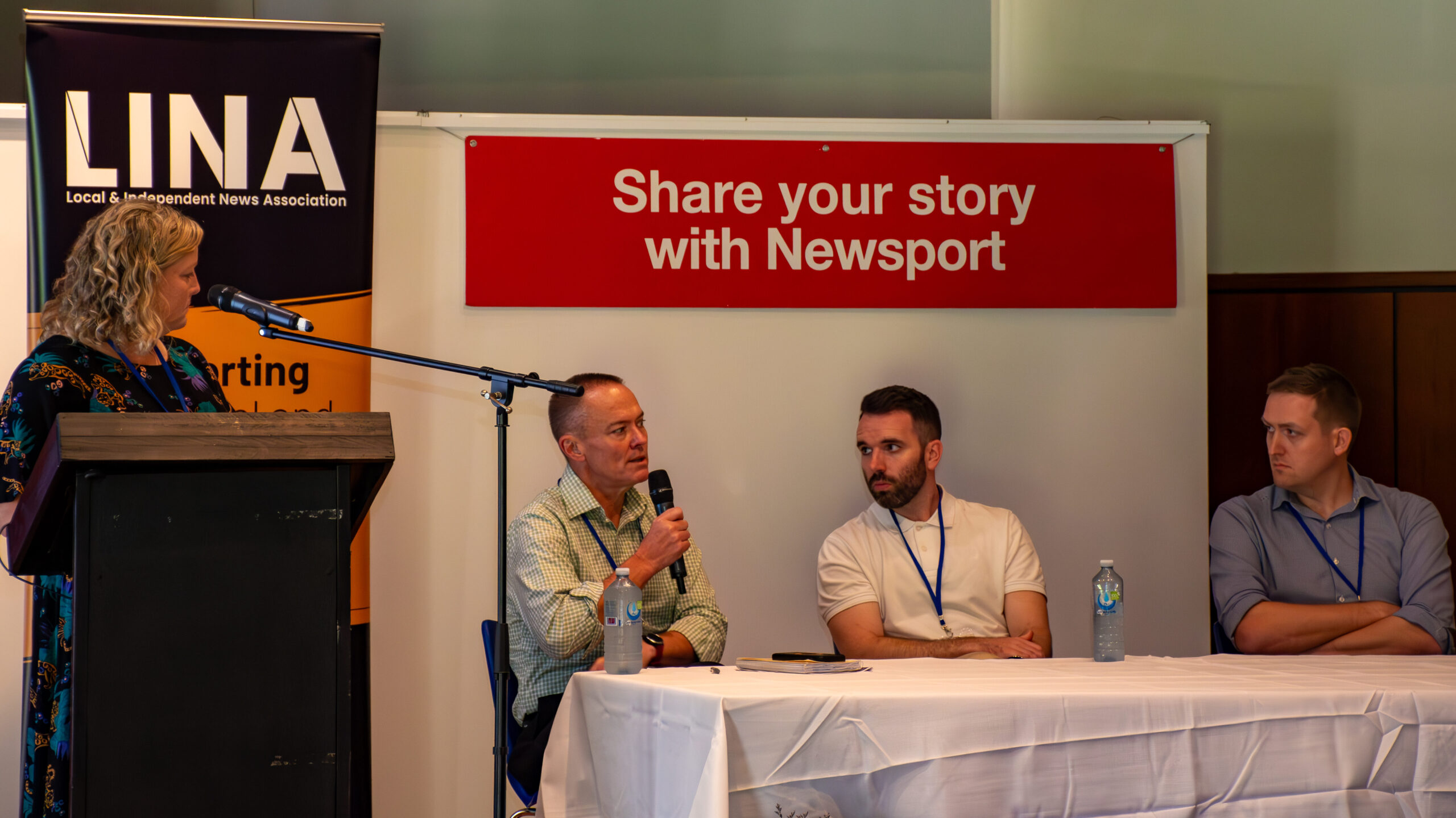
A panel discussion on building and maintaining audience trust within communities, with ABC Head of News Strategy and Innovation Stuart Watt, Edelman CEO Tom Robinson and AAP FactCheck Editor Ben James.
Key takeaways
- Trust in news outlets has been diminishing significantly over the past two decades, and people are more trusting of their local communities, who represent their day to day lives.
- Journalists and news organisations need to be differentiating themselves from the fast and loose reporting on social media.
- For local, independent reporters, the best move is to be personable and engaged in the community. The rhetoric becomes “I trust that person, therefore I trust the information.” A trusted reporter presents the information, the expert backs them up.
- Trust is earned over time, but trust isn’t as fragile as we might think. Don’t be led by fear.
Next steps
- When fact checking, be extremely conservative, follow exactly the same steps every time.
- Pause. Don’t share. Don’t digest. First ask yourself: Where has the information come from? Who is making this claim? What agenda might they have?
- Have they found evidence, have they linked to evidence? Does that link to evidence that is relevant to the claim?
- What do other trusted sources say? Break out of your usual algorithm.
- Be seen, let people know you’re a human being. Trust isn’t just being right 100% of the time. Build it by letting people know that you’re in the community, be open about mistakes, don’t hide away.
- Watch LINA Shop-talk webinar ‘Trust and Corrections’ for more.
Hon Michelle Rowland MP
Minister for Communications

Minister Rowland shared a video presentation praising the work of LINA and its members and re-iterating support for “media diversity and the sustainability of local, independent journalism”. Read the full speech.
Key takeaways
- LINA and members are informing the government’s approach to the News MAP.
- The News MAP policy framework is designed around four objectives: access, quality, diversity and engagement,
- The government is preparing to introduce legislation to hold digital platforms to account for seriously harmful misinformation and disinformation online.
Next steps
- Keep an eye on the LINA newsletter for more information on LINA’s advocacy work.
- Continue producing public interest journalism and share your impact with LINA (see ‘Know your value session’) so that we can use this to encourage government support for local and independent news.
- Contact your local MPs to reiterate LINA’s calls for government support for independent and local news publishers in the context of Meta’s updates to Facebook and Instagram services.
LINA Update
LINA – Claire Stuchbery
Claire Stuchbery provided an update on LINA’s progress and member services.
Key takeaways
- There are 66 LINA members, producing 106 newsrooms
- LINA members are publishing almost 80,000 stories per year
- Focus areas for LINA: strengthening public interest journalism, capacity building supports, networking and shared services. There is a myriad of member services available under each area – all based upon what members want.
- LINA’s board will soon be changing.
- You’re not alone, you have the LINA network as support. Thank you for being committed to your communities.
Next steps for LINA
- June 2024: Our News, Your Voice fundraising campaign.
- Continued representation in policy forums.
- Philanthropic focus to bring funds into the sector.
- Collective advertising project.
ACMA Update
ACMA – Katherine Anstee
ACMA provided a short update on its progress on the Media Diversity Measurement Framework and what the framework means for digital publishers.
Key takeaways
- The framework aims to broaden understanding of media diversity; source diversity, content diversity and exposure diversity.
- Implementation is in three phases:
- Phase 1 – Development of the first Media Diversity Measurement Report.
- Phase 2 – Biennial reporting through Media Diversity Measurement Report series.
- Phase 3 – Reviewing and evolving the framework.
Next steps
What this means for digital news publishers:
- The framework is designed to be platform neutral (more nuance about digital first news sources can be tracked).
- Government will have greater visibility of the contribution of digital news platforms to landscape.
- ACMA encourages LINA members to participate in the evolution of the framework – contribute to data, participate to LINA annual member survey, etc.
Know your value
LINA – Zahra Khalid, Impact Architects – Rosemary D’Amour
LINA’s Data & Insights Analyst Zahra Khalid led a panel discussion on measuring impact for newsrooms. Impact Architects’ Senior Manager of Media Impact Strategy and Engagement Rosemary D’Amour shared insights on how to implement an impact tracking system and the benefits for newsrooms of showcasing qualitative impact. Zahra and Rosemary were joined by Jacky Barker (In the Cove) and Susie Williams (Fleurieu App), who shared their experiences of setting up and using an impact tracking dashboard.
Key takeaways
- Impact tracking can help build your reputation, inform editorial strategy, gain institutional support e.g grants, advertising.
- LINA’s Impact Tracker (developed with Impact Architects), is free for members.
- There are two things to think about when deciding what to track: relevance of content and evidence of change.
Next steps
- Book a free session with Zahra to set up your impact tracker.
- Log impacts as they happen – it is much more manageable.
- If you have a bigger team, integrate it into your workflow. Two methods you could try: a centralised system where one person is responsible. Or a distributed system where everyone is asked to contribute impacts.
- Little impacts add up – don’t dismiss them.
Debate: Publishers must paywall news content to ensure sustainability
A debate between six LINA members
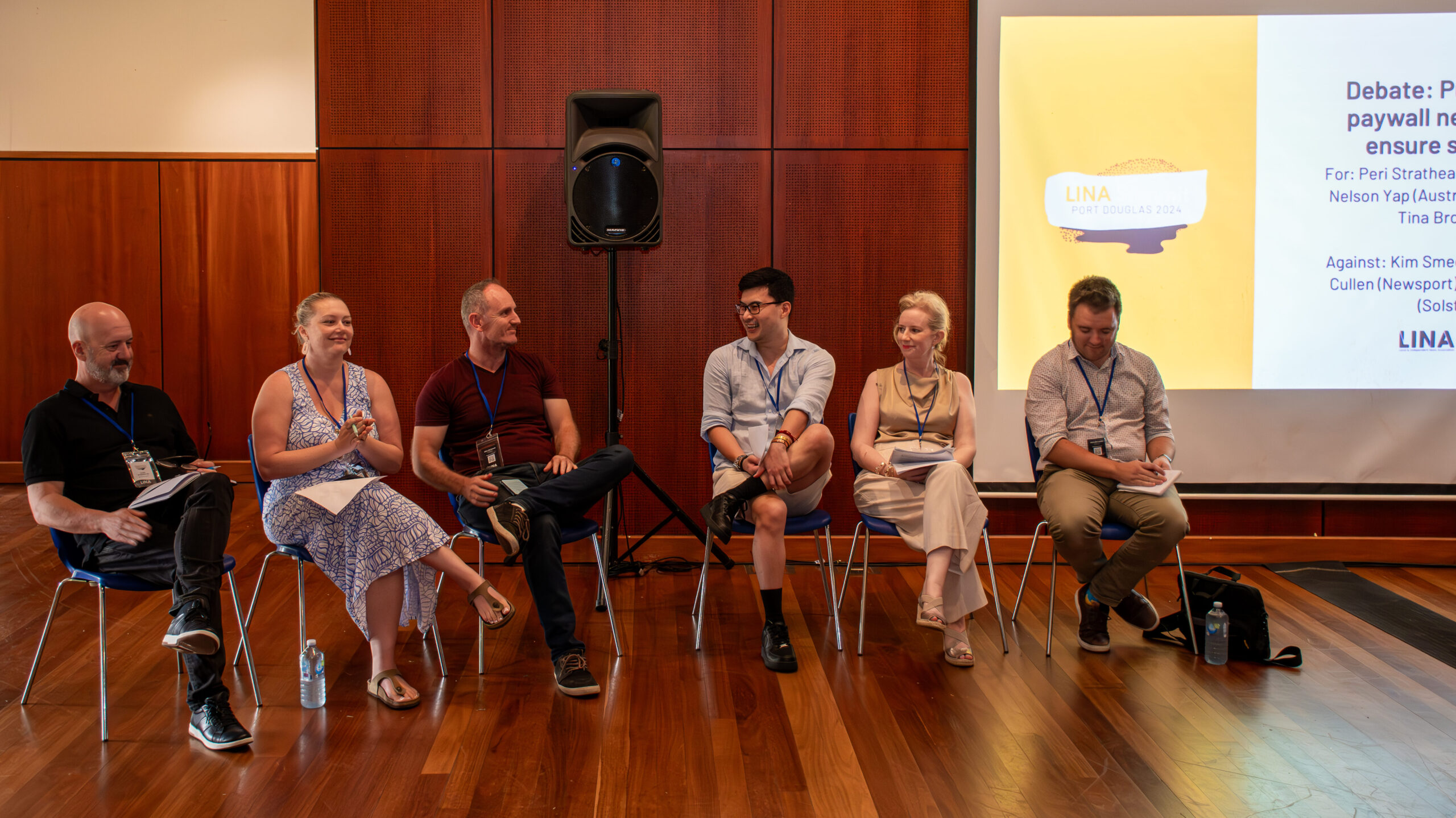
A lighthearted debate between publishers on the merits and/or evils of paywalling content.
Key takeaways
While there was no winner crowned, those supporting paywalls argued convincingly that quality news requires funding from its audience to produce, while those against put forward a strong case for why audiences must be able to receive news for free.
Arguing on the affirmative side: Peri Strathearn (Murray Bridge News), Nelson Yap (Australian Property Journal) and Tina Brown (The Post).
Arguing against: Kim Smee (Manly Observer), Sam Cullen (Newsport) and David Washington (Solstice Media).
Revenue Growth Pilot Program
Bastion Transform – Jenni Ryall and pilot program members
LINA members participating in the Revenue Growth Pilot Program joined Bastion Transform Group Director of Content and Media Jenni Ryall for a discussion about the income-based experiments they’re developing as part of the program.
Key takeaways
Pilot program projects:
- Jacky (In the Cove) – Starting a WhatsApp Page.
- Tina (The Post) – Looking to increase engagement with platform.
- Wyanita (NIRS) – Awareness campaign for the donations page.
- Lechelle (SE Voice) – Looking to grow revenue and increase “online” offerings.
- Rebecca (The Fold) – Creating a News Quiz for engaging audience, using as a ‘value add’.
- Diana Patton (Hills to Hawkesbury) – Dining guide with filters.
- Susie (Fleurieu App) – Increase social media engagement/combine media kits.
Next steps
- Submit an EOI if you are interested in joining a future Revenue Growth Program.
- Keep an eye on LINA’s newsletters for more information on revenue growth opportunities and inspiration.
- See the Revenue page in LINA’s Member’s Area for more tips.
SEO workshop
ABC – Jane Mower
Jane shared advice on how to shape news coverage around audience demands based on common search results.
Key takeaways
- SEO has moved on considerably since “keyword” search optimisation. It is now much more than retrofitting SEO to stories.
- News avoidance is now having a big impact on search, so we need to find ways to tap into topics people want to engage with.
- Pay attention to how people are using stories, reframe information that is already out there to make it useful.
- Summarise information so people can quickly find what they are commonly looking for.
Getting your story on the SERP (Search Engine Results Page) — what influences ranking:
- Great content
- Freshness
- Keywords
- Usability
- Engagement
- authority/trusted
- Prominence
Next steps
Areas to improve SERP (see slides for more details):
- Headlines — see slides for tips for improving ranking in SERP displays and “News SEO hierarchy” for writing headlines. If you have video, include that pointer in the headline.
- Publication and distribution e.g. best time and day to publish.
- Post-publication: after publishing, monitor your analytics and the SERP.
- Use story performance to inform future commissioning decisions.
Tools to try
Some tools suggested by Jane:
- Chartbeat
- Trisolute
- Google Analytics
- Google trends
Prepare for 3rd-Party Cookie Deprecation
Google – Chris Burgess
This session taught us about the impact cookie deprecation will have on our websites, and how to make the necessary changes before the change comes into place in 2025.
Key takeaways
- 3rd party cookies that are used for site functionality (like page navigation, sign ins, registration, payment, remembering user preferences) will be the ones that affect our websites.
- 15% of 3PCS for analytics – if you’re using an analytics page that’s not Google it won’t work anymore after the deprecation.
- Use the Privacy Sandbox Analysis tool: goo.gle/psat to run a cookie analysis. You can request extra time for deprecation if you get to 2025 and need more time to update your website.
Next steps
- Re group with your developers.
- Remove any remaining Universal Analytics code you have left running on your site.
- Update all site plug-ins and code libraries (eg marketing, site functionality, analytics etc).
- Report breakages.
Privacy Sandbox Analysis tool
When using the Privacy Sandbox Analysis tool:
- Select add to Chrome.
- Clear your cache, open your site in a new window.
- Select the extension and select analyse this tab.
- Go to DevTools for more detail.
Skills refresh: Interviews and writing tips
Community Media Training Organisation – Martin Corben
A brush-up on reporting skills in this workshop run by the Community Media Training Organisation. Covering how to get the most from your interviews, how to approach tricky topics in reporting and a refresher on best practice writing techniques.
Key takeaways
- Find the purpose of your interview and the type of interview e.g. information, accountability or discovery.
- Consider news values.
- Get the right person.
- Ask open questions.
Next steps
For more training, watch the recorded webinar from CMTO for LINA members on interviews and writing tips.
Grow your audience
Daily Motion – Jean-Baptiste Alary, Community Media Training Organisation – Dante St James
News avoidance is a rising concern, particularly among young audiences and women. This session looked at ways to reach audience groups — through multimedia content channels — that you might not be engaging currently.
Key takeaways
- 75% women and 67% men in Australia are actively avoiding news. Women are avoiding news because they don’t see the issues affecting them represented.
- Legacy media/big media still have big numbers in the 55+ audience. The younger audiences don’t engage in the same way and need to be captured now, or won’t be able to have them later on.
Next steps
- Focus on creating data driven news.
- To attract younger audiences use visuals, infographics, video that can be played on phone.
- Look at TikTok and the distilling of information, making things as simple as possible
Newsletter strategies
Unmade Media – Tim Burrowes, Hills to Hawkesbury – Diana Paton
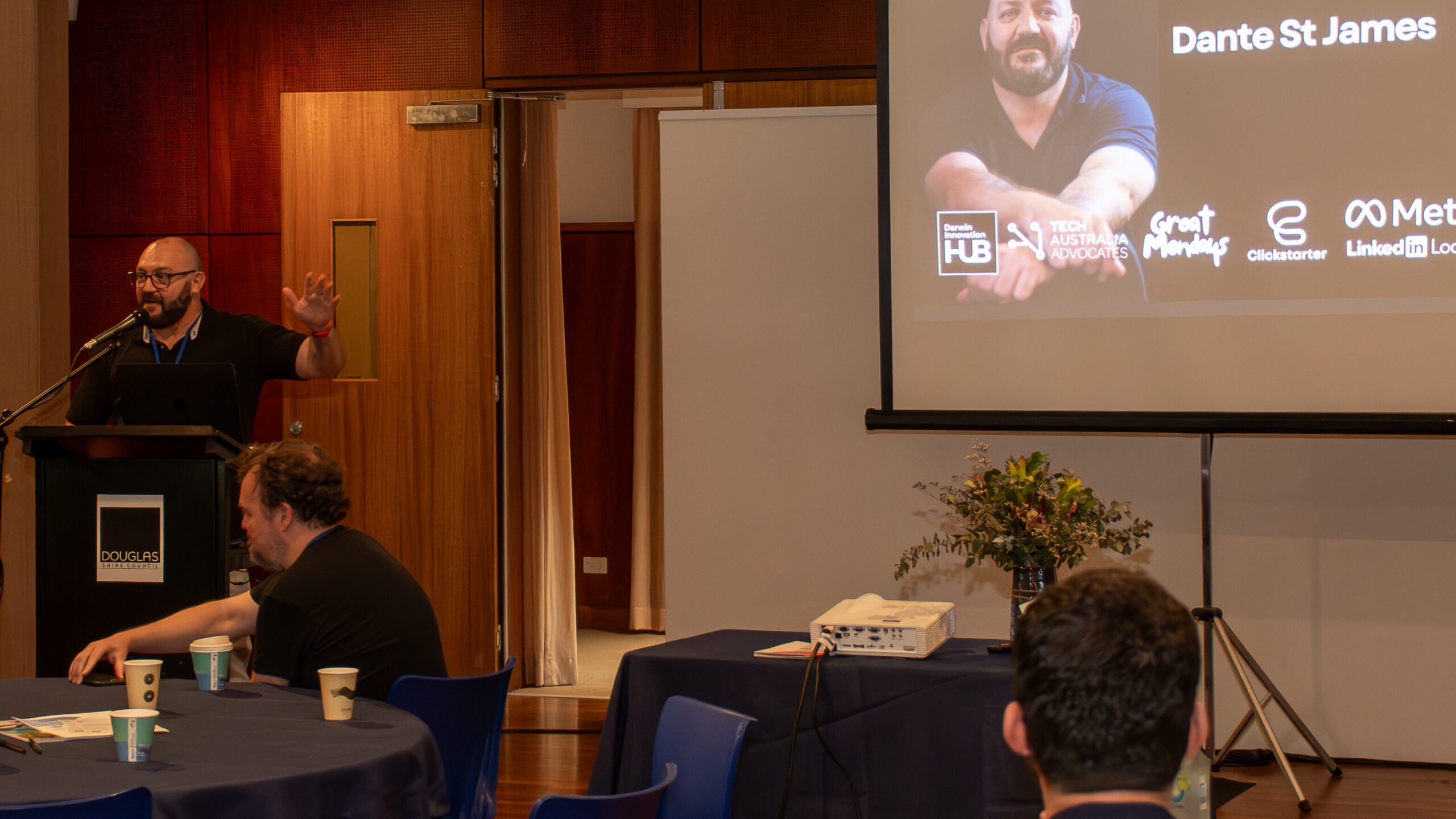
Rather than relying on social media algorithms to engage audiences, publishers can be pro-active about building direct newsletter lists to grow audience, revenue and engagement.
Key takeaways
- Newsletters helps you connect with the readers and are a source of revenue through advertisers — there is demand for newsletter advertising.
- Fluent is more automated than WordPress, it’s got its own dashboard but is a plugin for WordPress. It is easier to use than Newsletter Glue and has a graphic interface and drag and drop.
Next steps
- Be consistent with when you send newsletters, it builds a habit for readers to expect a newsletter at a certain time.
- Create newsletter subscription pop-up boxes on your website, e.g. ‘Subscribe to read more.’
- Run a campaign to drive newsletter subscriptions e.g. a giveaway from advertisers.
Solutions journalism
ABC – Suzanne Dredge, Missing Perspectives – Phoebe Saintilan
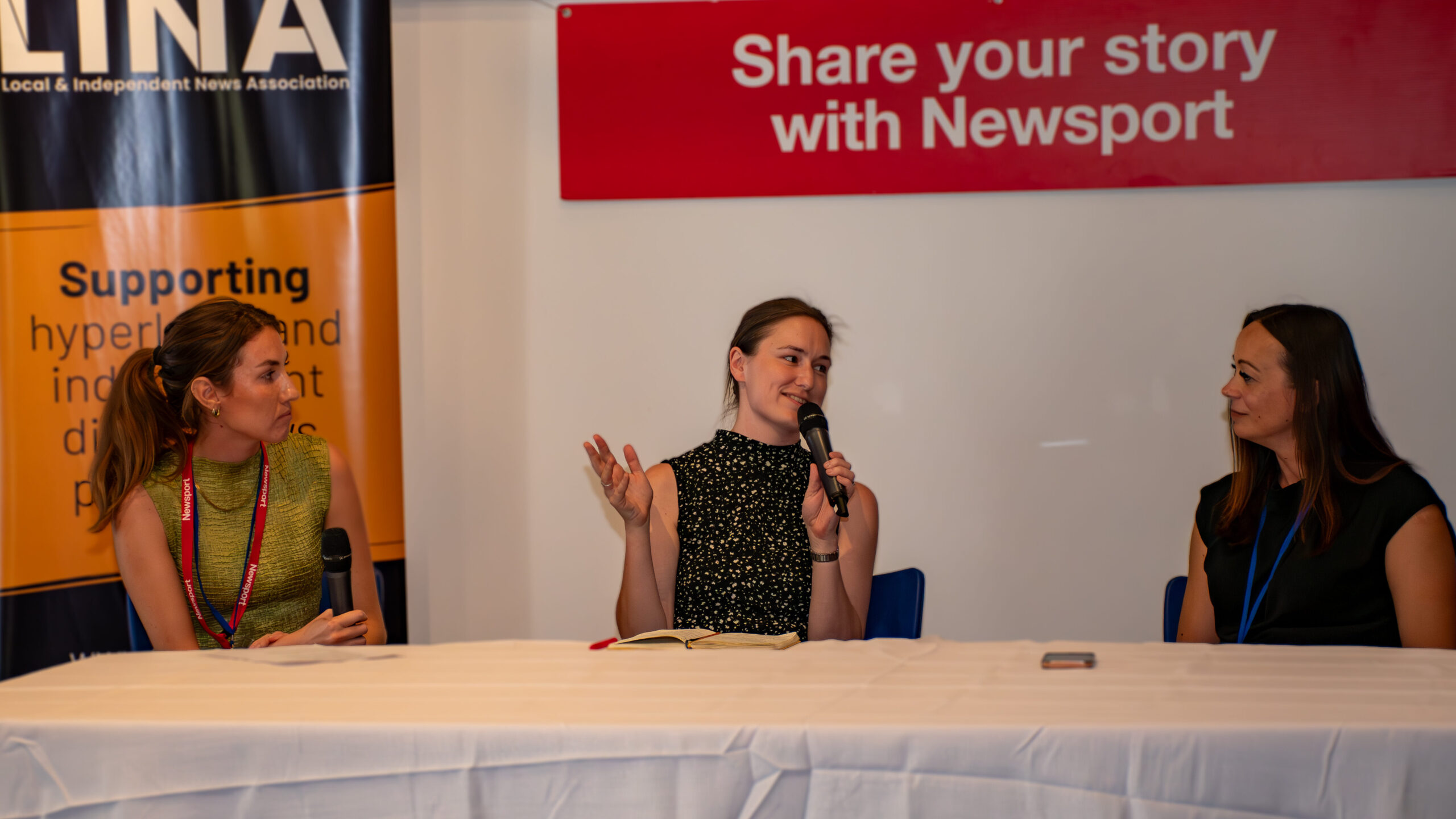
A panel discussion on our roles as journalists and publishers to produce solutions journalism, what exactly is solutions journalism, and the outcomes, benefits and challenges of this type of reporting.
Key takeaways
- Solutions journalism is the highest performing for audiences — people want more of this type of reporting.
- Solutions journalism doesn’t mean good news stories, advocacy or championing solutions.
- Time is an issue when producing solutions journalism and newsrooms have become reactive.
Next steps
- Watch the LINA shop-talk recorded webinar on Solutions Journalism.
- Consider how you can implement solutions journalism in your newsrooms’ reporting.
Workshops and discussions
Our News, Your Voice: Collective fundraising workshop
This workshop session prepared newsrooms to run a digital campaign, including how to use the digital toolkit developed specifically for local newsrooms and how to set up a payment portal to get matched funding for the campaign.
Key takeaways
- Giving week is between Monday 3 June and Friday 7 June, 2024.
- LINA gets a pool of donations to match funds that members raise from community (the aim is $100,000).
- LINA gives members all the tools to run the campaign: communications, assets and support.
- After the campaign is finished, LINA will transfer the matched funds directly to the members.
Next steps
- Sign up to the campaign if you have not yet done so.
- Send a save the date to your readers and then give them a countdown.
- Make a copy of the Canva assets provided and personalise these.
- Add Presspatron to your website for your donations.
- Members share their goals, share profiles of staff members and positive stories with readers about why local news matters.
- Add an embedded call-to-action element within articles.
- Add pop ups to target engaged users on websites.
- Add a prominent donation link.
- For printed publications: add a QR code for payment.
- Share your impact reports with your donors (high retention rates) or invite them as VIPS to events
Collective advertising working group discussion

This session was an opportunity to work together on a collective advertising representation: the model, the implementation, the tech, and how to start.
Key takeaways
15 publishers currently have the capacity and infrastructure to get started on collective advertising. LINA is considering starting with this group and then working with other members to get them set up.
Next steps
Check out these advertising guidelines to get started with digital advertising.
HR Challenges

This session was for people managing small teams, or preparing to take on staff, exploring potential solutions to issues like staff retention and sharing common challenges across all areas of personnel management.
Key takeaways
Publishers face challenges in the following areas:
- Management structures to support employees, including processes for managing KPIs, induction processes, invoicing and checking processes to manage freelancers.
- Job descriptions
- Contracts
Next steps
Use LINA’s HR Help request form to get free advice and support from a HR consultant.
Among friends: Conference debrief
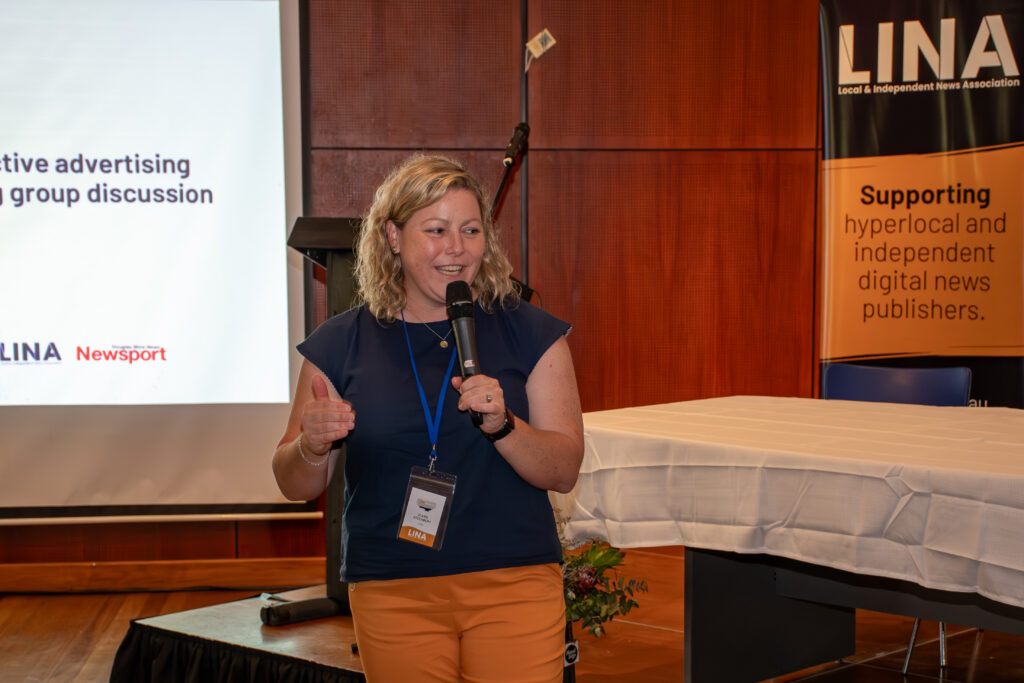
An opportunity to reflect on the take-outs from the last couple of days, and for LINA to receive feedback to inform next steps for the association.
Key takeaways
- Keep evolving. Readership is changing and publishers need to keep up.
- It’s OK to feel like you’re winging it. Most of us are, you’re not alone!
- Local news is an integral part of connecting our communities.
Next steps
LINA is reviewing all of the feedback provided by members and will be addressing this in new member services, training, resources and the 2025 Summit.
Member Profile Presentations
*PS Media
Simon Crerar

Western Sydney Publishers
Troy Dodds
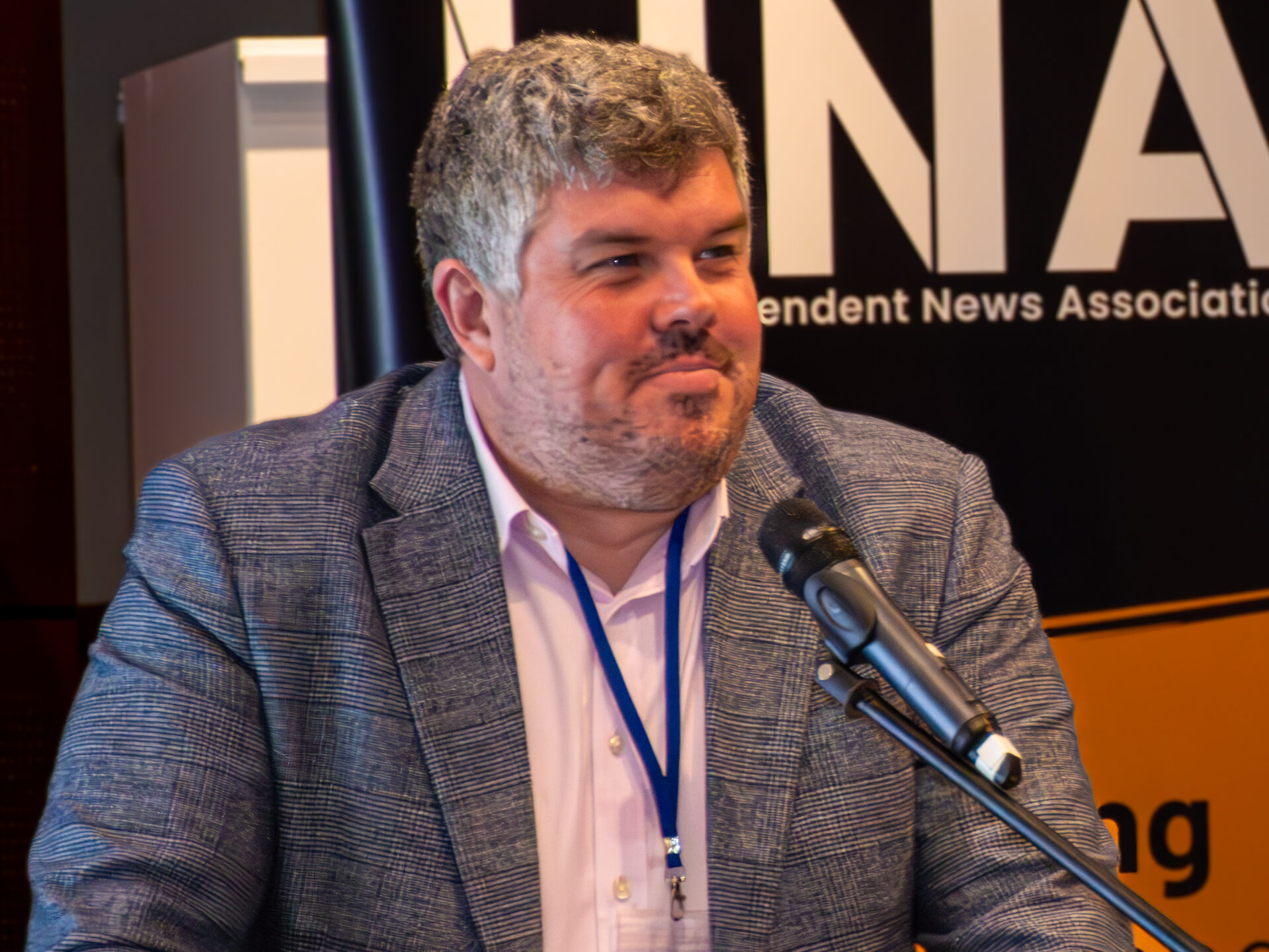
SE Voice
Lechelle Earl
